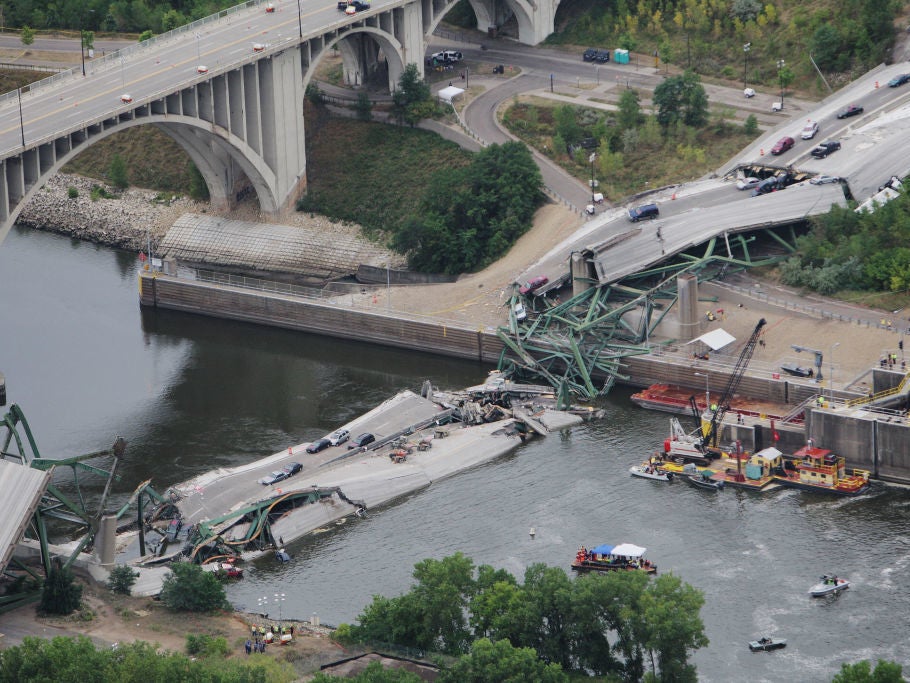Climate crisis: One in four steel bridges in US ‘could collapse by 2050’ due to extreme temperatures, study says
Thousands of ageing bridges in America at risk of failing if authorities do not prioritise maintenance, researchers say

A changing climate takes a physical toll on infrastructure built with more predictable weather patterns in mind.
Materials such as steel expand in hot weather and contract again in cold temperatures. Seasonal variations in temperature have usually been accounted for by designers, but as extreme weather events become increasingly common, designs and materials are being tested to their limits.
US engineers are now turning their attention to the problems this can pose for the structural integrity of the country’s ageing transport network, which includes around 600,000 bridges.
An analysis by a team from Colorado State University suggests authorities should rethink the priority order of bridge repair, as climate change looms and infrastructure funding is limited.
The failure to assess bridges’ integrity was tragically demonstrated last year when an Italian road bridge built in the 1960s collapsed with no warning in the city of Genoa, killing 43 people.
Associate professor Hussam Mahmoud and Susan Palu focused their analysis on about 80,000 “simply supported steel girder bridges,” a design common in the US since the mid 1940s, which consists of longitudinal beams spanning two piers.
These bridges suffer frequently from expansion joints clogging with debris and require regular maintenance to clean the joints. Expansion joints connect bridge spans and allow the structure to expand and contract as the air heats or cools.
When joints become clogged, they prevent the bridge from expanding normally in response to higher temperatures. The researchers reasoned that higher average temperatures in the future, not accounted for when such bridges were first built, could lead to unforeseen thermal stress.
Heat stress can cause buckling and cracking, which are exacerbated by both bending from the weight of lorries and cars, and axial loading from the expansion restriction. The study is the first to quantify the impact of potential temperature changes in conjunction with normal expected clogging of expansion joints.
The researchers considered four different seasonal scenarios for temperature at the time of each bridge’s construction, along with projected average temperatures for the years 2040, 2060, 2080 and 2100.
The projected temperature rises are the “radiative concentration pathway” greenhouse gas warming scenarios adopted by the International Panel on Climate Change in 2014.
Results indicate that bridges located in the northern portion of the United States, including the Northern Rockies and Plains, Northwest and Upper Midwest, are the most vulnerable to more pronounced increases in temperatures.
Less susceptible regions were the southeast and northeast.
The engineers’ aim was to rank bridges in order of needed maintenance after accounting for the new normal of climate change.
They found that current temperature extremes aren’t likely to cause severe problems, however, they are getting closer to reaching levels which could cause catastrophic failures.
They say one in four bridges are at risk of failing by 2040, and by 2060 this rises to 28 per cent. By 2080 just under 50 per cent of bridges were deemed a risk, and almost all studied are predicted to have failed by the end of the century if no interventions are made.
“We as engineers must start to look beyond what we have initially been taught on how to analyse systems and start to think about what climate change is going to do to our understanding of component-level behaviour and system-level performance,” Dr Mahmoud said.
“Neglecting possible future climate change can jeopardize the integrity of many US bridges.
“Efficient maintenance to keep the expansion joints functional, on a regular basis, is vital to avoid undesirable thermal demands that will potentially be magnified due to climate change,” the study says.
The research is published in the journal Plos One.
Join our commenting forum
Join thought-provoking conversations, follow other Independent readers and see their replies
Comments
Bookmark popover
Removed from bookmarks